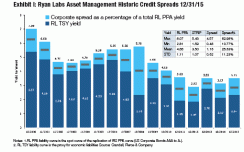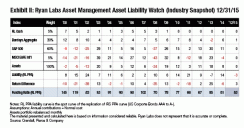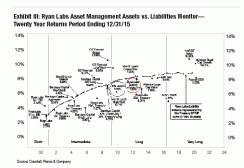A conversation with Sean McShea, the President of Ryan Labs Asset Management, a Sun Life Investment Management company.
To view a PDF of the full report, click here.
Institutional Investor recently talked with Sean McShea, the President of Ryan Labs Asset Management, based in New York, to discuss the state of the market in liability driven investment (LDI) for pension funds.
Institutional Investor: In 2015 Sun Life Financial Inc. acquired Ryan Labs Asset Management for its third party asset management business, Sun Life Investment Management. With Ryan Labs having over $6 billion in assets under management as of December 31, 2015, what does this mean for your clients?
McShea: Sun Life has had great success over the last 150 years in Canada; with Sun Life Investment Management, their strategy with us is to grow their institutional footprint in the United States over the next few years. With a strong parent and one with core strength in LDI, we now have a large balance sheet supporting our operations. When a plan sponsor does a search for an asset manager, the last thing that they want to worry about is that the asset manager may not be there for the long run. We now have insight into insurance risk management tools that may apply to our pension fund clients.
How do retirement vehicles remain economically sustainable for the long term with volatile markets?
The goal of any pension plan is to be solvent and sustainable for the plan sponsor and participants. Therefore, a plan sponsor needs to be comfortable in the case of an adverse event. For pension plans the focus needs to be on the plan’s contribution, distribution, and asset diversification strategies. The plan sponsor needs to think about the various risks associated with the plan. For example, how big is the plan relative to the balance sheet? Should we hedge mortality risk? DC pension plans look at risks at the individual plan member, such as the risk of starting retirement just before or after a market correction.
Why execute on an LDI strategy now when interest rates are historically low?
Most LDI clients are more focused on risk management than making a call on interest rates. Most plans need to focus on the asset/liability math; with current interest rates a small change can make a big impact on solvency. For plan sponsors of DB pension plans considering LDI, they are trying to remove much of the systematic risk from their plan. From a timing perspective, bond spreads have widened and corporate bond rates are higher over the last couple of quarters. (See Exhibit I.) When we look at implementing LDI, clients are often taking their existing fixed income allocation within a 60/40 plan and managing it to an LDI benchmark. Yields can be enhanced by adding credit as the asset duration is aligned to liability duration. Understanding how the pension plan fits into the company’s overall risk profile is important.

Should a pension plan use derivatives?
Many tools in the kit are beneficial for risk management and asset replication. Derivatives can be a great tool; adding futures and swaps to focus on risk management can be very effective in shaping outcomes. With derivatives, plan sponsors can manage their allocation changes without making changes to their physical securities. With LDI mandates in particular, plan sponsors want to make sure that their overlay manager has strong capabilities in governance, documentation, and back office. If there is a disruption, derivatives can be used to reduce the downside or provide a capital market risk offset.
Why should pension plans focus more on risk management?
The LDI framework will provide a coherent structure between the liabilities and assets. LDI may drive asset allocation, money management, risk management, and performance attribution.
How do you judge the success of the current state of core DB pension plans?
On average corporate plans are only 83 percent funded, as of December 31, 2015. The strategy to close any underfunding should align with any other funding decisions. (See Exhibit II.)

How does the plan size versus market capitalization impact a plan sponsor’s decision to implement LDI?
Plan sponsors need the risk capacity to sponsor the plan and its current funding volatility. If the pension plan’s size and funding volatility is large vis-à-vis the balance sheet, then they need to apply more LDI tools.
What level of credit risk should a pension plan consider hedging?
Plan sponsors should look to a long duration credit portfolio to hedge the nature of their liabilities, because the plan sponsors value their liabilities on a corporate curve for financial disclosure and funding. A natural hedge should be a bond portfolio that has a similar duration and spread to the liabilities.
Plan advisors need to understand the structure of liabilities, and the embedded credit within the liability discount curves (financial disclosure or funding). In the case of pension plans, liability valuation is made up of a 100 percent credit curve.
What are the products that provide more return than liabilities without the risk of equities?
Infrastructure, private fixed income, real estate and mortgages can provide additional yield with lower volatility than equities. These are all asset classes that larger plans and insurance companies are using effectively today. Plans need some liquid assets, based on their plan characteristics. Liquidity risk is being studied at a much more detailed level now than 20 years ago. There is no free lunch. (See Exhibit III.)

What is your approach to LDI?
The first step is helping the plan sponsor understand its pension risk, generating a company diagnostic to document through key risk elements that they need to consider. Once we agree on the risk parameters, we manage the LDI portfolio versus a custom liability benchmark and we take active credit bets to meet or outperform the liabilities. We had tremendous success with this approach – we have beaten our LDI client composite benchmark for 15 consecutive years, through a variety of interest rate and credit environments.
Contact Information
Sean F. McShea, President
500 Fifth Avenue, Suite 2520, New York, NY 10110
Tel: (646) 708-8052 | (800) 321-2301 Ext. 8052
Fax: (212) 202-4252 | Cell (917) 774-5207
Email: smcshea@ryanlabs.com
Web: www.ryanlabs.com





